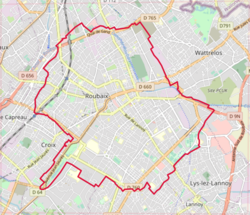
Back Roubaix ACE Roubaix Afrikaans Roubaix ALS ሩቤ Amharic Roubaix AN Rube ANG روبيه (مدينة) Arabic مدينه روبيه ARZ Roubaix AST Rube Azerbaijani
Roubaix
| |
|---|---|
 The Hôtel de Ville (City Hall) | |
| Motto: Probitas et Industria | |
 | |
| Coordinates: 50°41′24″N 3°10′54″E / 50.6901°N 3.18167°E | |
| Country | France |
| Region | Hauts-de-France |
| Department | Nord |
| Arrondissement | Lille |
| Canton | Roubaix-1 and Roubaix-2 |
| Intercommunality | Métropole Européenne de Lille |
| Government | |
| • Mayor (2020–2026) | Guillaume Delbar[1] |
Area 1 | 13.23 km2 (5.11 sq mi) |
| Population (2022)[2] | 99,507 |
| • Density | 7,500/km2 (19,000/sq mi) |
| Demonym(s) | Roubaisian (en) Roubaisien(ne) (fr) |
| Time zone | UTC+01:00 (CET) |
| • Summer (DST) | UTC+02:00 (CEST) |
| INSEE/Postal code | 59512 /59100 |
| Elevation | 17–52 m (56–171 ft) (avg. 35 m or 115 ft) |
| Website | www |
| 1 French Land Register data, which excludes lakes, ponds, glaciers > 1 km2 (0.386 sq mi or 247 acres) and river estuaries. | |
Roubaix (US: /ruːˈbeɪ/ roo-BAY, French: [ʁubɛ] or [ʁube] ⓘ; Dutch: Robaais; West Flemish: Roboais; Picard: Roubés) is a city in northern France, located in the Lille metropolitan area on the Belgian border. It is a historically mono-industrial commune[3] in the Nord department,[4] which grew rapidly in the 19th century from its textile industries, with most of the same characteristic features as those of English and American boom towns.[5][6] This former new town has faced many challenges linked to deindustrialisation such as urban decay,[7] with their related economic and social implications, since its major industries fell into decline by the middle of the 1970s. Located to the northeast of Lille, adjacent to Tourcoing, Roubaix is the chef-lieu of two cantons and the third largest city in the French region of Hauts-de-France ranked by population with nearly 99,000 inhabitants.[8]
Together with the nearby cities of Lille, Tourcoing, Villeneuve-d'Ascq and eighty-six other communes,[9] Roubaix gives structure to a four-centred metropolitan area inhabited by more than 1.1 million people: the European Metropolis of Lille.[10][11][12] To a greater extent, Roubaix is in the center of a vast conurbation formed with the Belgian cities of Mouscron, Kortrijk and Tournai, which gave birth to the first European Grouping of Territorial Cooperation in January 2008, Lille–Kortrijk–Tournai with an aggregate population of over 2 million inhabitants.[13]
- ^ "Répertoire national des élus: les maires". data.gouv.fr, Plateforme ouverte des données publiques françaises (in French). 2 December 2020.
- ^ "Populations de référence 2022" (in French). The National Institute of Statistics and Economic Studies. 19 December 2024.
- ^ Pooley, Timothy (30 December 1996). Chtimi: The Urban Vernaculars of Northern France. Applications in French Linguistics Series. Clevedon, UK: Multilingual Matters Ltd. pp. 15–44. ISBN 978-1-853-59345-1. Retrieved 1 July 2015.
- ^ INSEE commune file
- ^ Lecigne, Constantin (1911). Amédée Prouvost (in French). Paris, F: Bernard Grasset. p. 71. OCLC 679906866. Retrieved 17 March 2016.
Roubaix donne l'impression d'une enclave américaine dans la France du Nord. C'est en même temps la ville de l'énergie frénétique et des fuites à travers le monde.
- ^ Strikwerda, Carl (1984). Sweets, John F. (ed.). "Regionalism and Internationalism: The Working-Class Movement in the Nord and the Belgian Connection, 1871–1914". Proceedings of the ... Annual Meeting of the Western Society for French History. 1983/1984. Lawrence (Kansas), USA: The University of Kansas: 222. hdl:2027/mdp.39015012965524. ISSN 0099-0329.
Contemporaries never tired of calling Roubaix an "American city," because of its raw, fast-growing character, or of referring to Roubaix and its sister cities of Lille and Tourcoing as the "French Manchester."
- ^ Clark, Peter (29 January 2009). European Cities and Towns: 400–2000. Oxford, UK: Oxford University Press. p. 246. ISBN 978-0-199-56273-2. Retrieved 1 October 2015.
Roubaix was another new town, originally a craft village, whose many textile mills attracted a population of 100,000 and generated massive social and environmental problems.
- ^ Téléchargement du fichier d'ensemble des populations légales en 2019, INSEE
- ^ Lecluyse, Frédérick (16 December 2016). "MEL: on prend les mêmes ou presque et on recommence" [MEL: let's take the same ones, or almost, and start over]. La Voix du Nord (in French). 73 (349, ROUBAIX & SES ALENTOURS). Roubaix, F: 4. ISSN 1277-1422.
Bois-Grenier, Le Maisnil, Fromelles, Aubers et Radinghem-en-Weppes. Soit 6000 habitants supplémentaires pour une MEL qui compte désormais 90 communes…
- ^ Ezelin, Perrine (2 April 2015). "European Metropole of Lille Local Action Plan" (PDF). Edinburgh, UK: CSI Europe URBACT. p. 3. Retrieved 22 July 2015.
- ^ URBACT (29 May 2015). "Lille". Edinburgh, UK. Archived from the original on 22 July 2015. Retrieved 22 July 2015.
- ^ Neveu, Clarisse (15 December 2016). "Métropole Européenne de Lille: les vice-présidents et conseillers métropolitains délégués élus" [European Metropolis of Lille: elected vice-presidents and metropolitan delegate-councilors]. MEL. Communiqué de presse (in French). Lille, F: Métropole Européenne de Lille. Retrieved 18 December 2016.
La fusion, effective au 1er janvier 2017, acte un élargissement historique du territoire de la Métropole Européenne de Lille, passant de 85 à 90 communes pour près d'1.2 million d'habitants.
- ^ Durand, Frédéric (12 May 2015). "Theoretical framework of the cross border space production the case of the Eurometropolis Lille-Kortrijk-Tournai" (PDF). Luxembourg, L: EUBORDERSCAPES. p. 18. Retrieved 22 July 2015.



